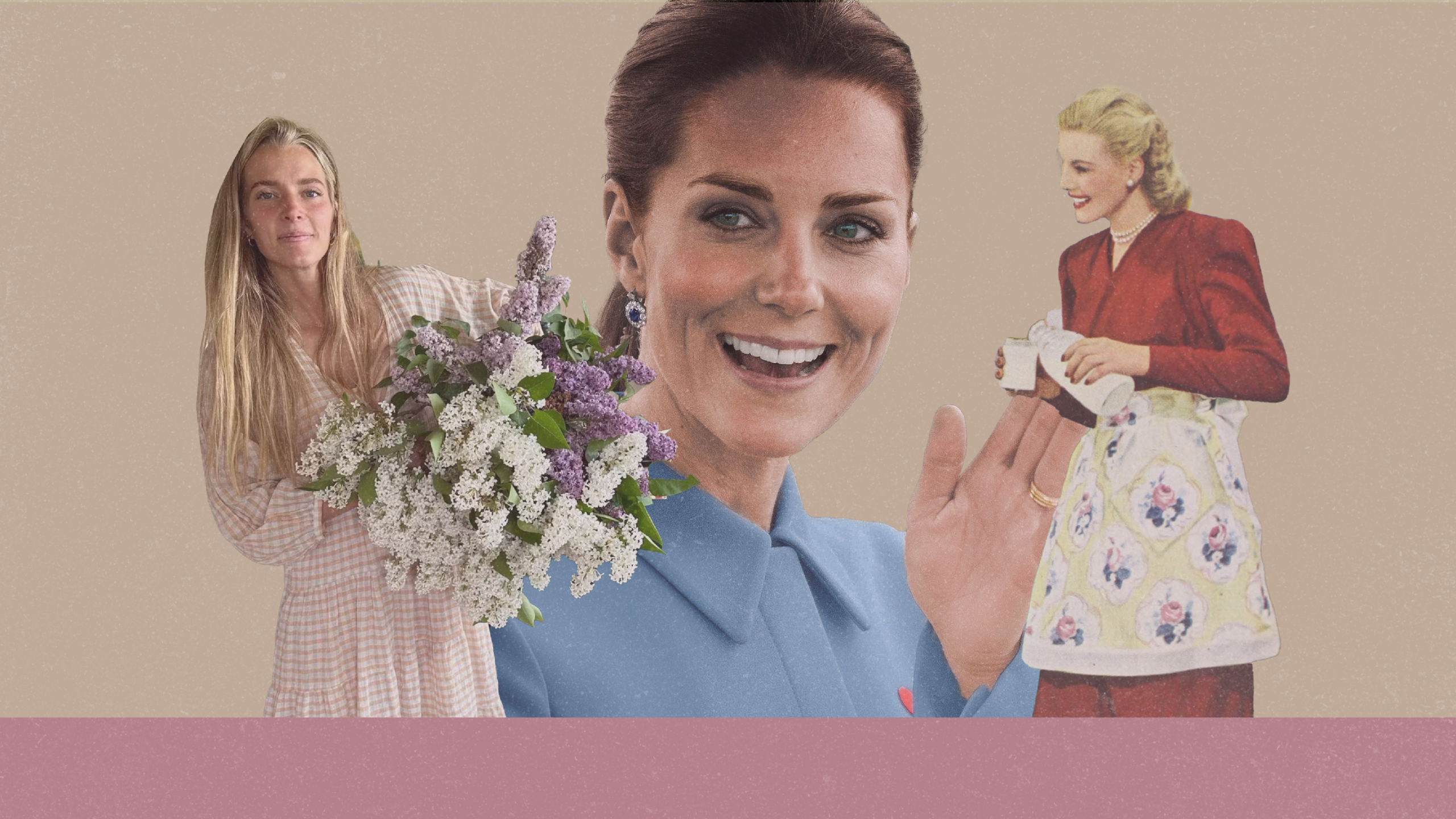March is Women’s History Month in the US, and a quote attributed to St. Edith Stein is ubiquitous across the Catholic social media landscape. “The world doesn’t need what women have,” the saying goes. “It needs what women are.”
That such words are appearing all over Instagram at this moment is perhaps providential, since the social networking site is in many ways the home of performative femininity. Now, “femininity” is a word that can sound outdated and a little precious. But if we define “femininity” simply as “what women should be like,” it is still very much alive and well. Influencers on Instagram and TikTok are once again repackaging the second wave feminist “you-can-have-it-all” cultural messaging that everyone from the Murphy Brown writers’ room to the Spice Girls have reinvented for their time. And as in many other areas of life in 2024, “having it all” can look a lot of different ways, because everyone can define for themselves what that means. Whether it’s the perfect skincare routine, morning ritual, or side hustle, there are plenty of voices on social media telling women how they can hack their minds, bodies, and lives for optimal performance and happiness. But somewhat surprising in this ferment is the popularity of the “tradwives,” women whose performative best life includes a return to traditional gender roles, domestic tasks, agrarian work, and slow, natural living. It’s a life characterized by simplicity and a rustic aesthetic. And like their influencer sisters pushing lip fillers, botox, self-care, and lash extensions, they are viewed by millions of women through screens. They are being scrutinized—by turns enviously, critically, and aspirationally—not for who they are, but for what they have.
I queried my normie friends to see if they were familiar with the tradwife trend (an occupational hazard of being a writer is spending a lot of time online, so I wanted to make sure I was making sense). Most had never heard the term, but were familiar with the concept. “Christian moms who film themselves baking and talk about homeschooling their kids,” one of my friends said when I asked her. It was perhaps the most pithy summary of the way the trend is perceived, both by its admirers and detractors.
For the uninitiated, the best starting place to familiarize yourself with the tradwife (that’s a portmanteau of “traditional wife,” if you hadn’t figured it out) is an Instagram account called Ballerina Farm. A former ballerina and 2023 Mrs. America, Hannah Neeleman runs an Instagram, TikTok, and YouTube account chronicling life on her Utah farm, where she and her husband are ranchers raising eight children. She is beautiful, poised (“She Gave Birth Two Weeks Ago. Now She’s in a Beauty Pageant” is a headline from the New York Times profile of Neeleman earlier this year). She is also, as her well-appointed home indicates, rich—her father-in-law is a co-founder of multiple airlines.

Neeleman herself claimed she was unfamiliar with the term “tradwife” in her February 2024 New York Times profile and said that she simply thinks “everyone’s mission is different. I find so much joy and satisfaction in being with my kids.” Statements like these, and the content she posts of joyful rural family life, mean that some conservative media outlets are keen to tout Neeleman as a champion of motherhood and childrearing. In a time when interest in both are on the decline, a high-visibility example of the choice to raise a family is welcomed by many.
But there are consequences to making an avatar out of a beautiful woman who has time and resources, whose curated life we know only through literal snippets. And the consequences are real not only for the women who are on the receiving end, both of the criticisms and the accolades, but for the consumers as well.
An ongoing internet mystery explains the downsides of this phenomenon. She may not homeschool (except during COVID), and unlike the tradwife stereotype, she is vaccinated. But while she has a closet of designer clothes and access to diamond tiaras, you don’t get much more “traditional” and “wife” than Princess of Wales. Kate Middleton’s job is to be almost literally the embodiment of both concepts, and her extended absence from public life, announced in January of this year, launched a thousand conspiracy theories. Her humanity having been reduced in the minds of many to public roles performed for public consumption, when she stopped performing them, the public rushed to fill the vacuum.
Used to the regular appearance of curated scenes from her very traditional life—attending church, baking with her children, family rambles in the countryside, everyone dressed up for the cameras—many found it inconceivable that Kate was actually having, as the palace press release said, “planned abdominal surgery,” which would require months of recovery. When a doctored image of Kate with her children was issued on Mothering Sunday (British Mother’s Day), sharp-eyed social media users rushed to find and report the anomalies.
Only one comment I saw in the online speculation over the royal Photoshop disaster approached what is the most likely reason someone in Kate’s situation would issue a less-than-truthful photo of themselves. “She probs just looks like she’s had an operation,” the Twitter user wrote, “and the last thing she needs is being photographed when she’s meant to be perfect all the bloody time. I’m exhausted for her.”
Anyone who has ever used “portrait mode” on their iPhone will understand.
Like Delta House, the Royal Family has “a long tradition of existence,” and their continued popularity in the UK and abroad shows that that carries undeniable appeal. Likewise, the draw of social media accounts where women show themselves and their families living simple, ordered lives that are rooted in tradition, clearly speaks to something that is hardwired in the human condition.
“Because of our traditions . . . every one of us knows who he is, and what God expects him to do.”
The Case of the Missing Princess proves that the performative, selective nature of social media is perhaps not the best outlet to address the human need for ritual, family, connection, and continuity. Even when very real goods and truths live purely online, there is nothing tangible for viewers to hang onto in their absence. What these internet sleuths are clamoring for is proof of the real, flesh-and-blood Kate Middleton. No longer thought of as embodied persons, Kate and her children were reduced to their component parts, broken down and fractured by strangers for their own entertainment. The focus shifted away from who she is, to what she has: in this case, a mismatched zipper, an out-of-focus hand, a missing wedding ring.
But the Windsors have an advantage over the average influencer, which is that they don’t just exist on screen for their followers. They do in-person events, attend religious services, and appear at public ceremonies. By contrast, most social media influencers are offering something that, for most of their followers, is brief and ephemeral—the opposite of tradition.
There is nothing wrong with an urge for simplicity, a calling to raise children within marriage, or an agricultural vocation. But by definition, anything done in front of a screen is done for show. It is easy to forget that, especially when an account is focused on what is natural and good. But just as I have been made to feel bad about my body, my clothes, and my overall lifestyle by a picture of Kate and her children immaculately turned out at Westminster Abbey, I have been made to feel less-than by social media accounts where a beautiful mom in a smocked peasant dress bakes beautiful pastries for her small children in her farmhouse kitchen.
And if it’s true that Kate is exhausted and feeling put-upon by millions of people scrutinizing her appearance, it would be understandable. Kate, if you’re reading this, you’re welcome to come to our less-than-glam house in the North Carolina exurbs to recuperate. I’ll give you the tradwife version of America Ferrerra’s “It is literally impossible to be a woman” speech from the “Barbie” movie. Because it is literally impossible to be a social media tradwife. You have to be modest, but still attractive. You have to be a great mom, but never take any time for yourself. You have to make everything from scratch, but you also have to know your angles while you’re doing it for the ’Gram.
Rather than following accounts that commodify traditions and family life for likes or ad revenue, our time might be better spent thinking about just why it is that those things are attractive to us. I find myself thinking about the definition of tradition offered by Tevye, a poor dairy farmer, decidedly not of the Ballerina variety, in “Fiddler on the Roof”: “Because of our traditions,” he tells the audience, “every one of us knows who he is, and what God expects him to do.”
Hannah Neeleman was saying something similar when she told the New York Times that she believes each one of us has a mission. And Edith Stein was telling the women of today something similar when she said that the world doesn’t need what they have—even if that’s a perfect rustic kitchen, an ideal homeschool room (or even children), a thriving herb garden, or a flattering nap dress. It doesn’t need what they have even if it’s a business empire, lucrative investments, or a great tan, smooth skin, and a snatched waist. It doesn’t need those things. It just needs women to show up, in person, to fulfill their missions.
